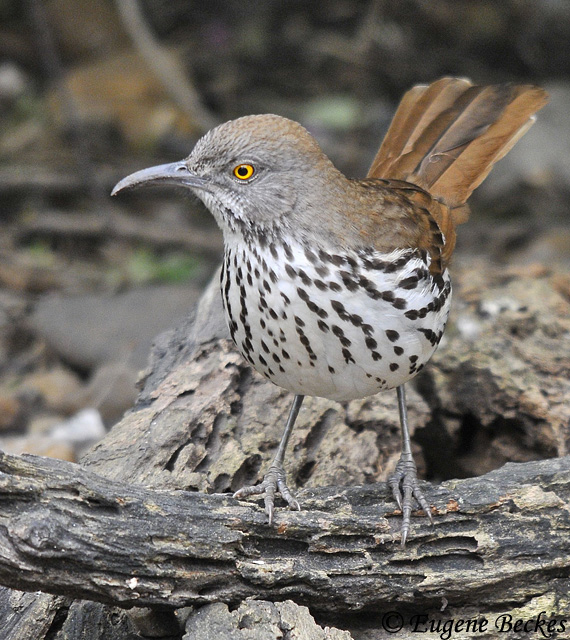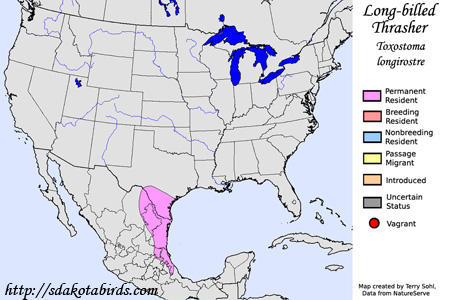| Length: 11.5 inches | Wingspan: 12 inches | Seasonality: Non-resident in South Dakota |
| ID Keys: Dark brown upperparts, white below with black streaks, gray face | ||
 The
Long-billed Thrasher is a close relative of the
Brown Thrasher. While the Brown
Thrasher has a widespread range across much of the United States and
southern Canada, the Long-billed Thrasher only enters the U.S. in southern
Texas, where they can be fairly common. Their range does overlap with
the Brown Thrasher, particularly during winter months when migrating Brown
Thrashers may enter areas with Long-billed Thrashers. The Long-billed
Thrasher can be distinguished from Brown Thrashers by their duller, less
"rich" plumage on the upperparts, their gray face, and their very white
underparts with black streaks. Brown Thrashers have a richer rufous
color above, a bit of a buffy tinge to their underparts, and streaks that
range from rufous to very dark brown.
The
Long-billed Thrasher is a close relative of the
Brown Thrasher. While the Brown
Thrasher has a widespread range across much of the United States and
southern Canada, the Long-billed Thrasher only enters the U.S. in southern
Texas, where they can be fairly common. Their range does overlap with
the Brown Thrasher, particularly during winter months when migrating Brown
Thrashers may enter areas with Long-billed Thrashers. The Long-billed
Thrasher can be distinguished from Brown Thrashers by their duller, less
"rich" plumage on the upperparts, their gray face, and their very white
underparts with black streaks. Brown Thrashers have a richer rufous
color above, a bit of a buffy tinge to their underparts, and streaks that
range from rufous to very dark brown.
Habitat: Found in shrubby areas and in thick woodland undergrowth, often near water sources.
Diet: Feeds on insects and spiders, as well as some feeding on seeds, fruits, berries, and small vertebrates such as small frogs and lizards.
Behavior: Mostly feeds on the ground, walking along in search of insects and using its bill to overturn leaf-litter and rocks. They will also use their bill to make shallow probes in the ground.
Nesting: The nest is a bulky cup of sticks and twigs, lined with softer vegetative material such as grasses or roots. The nest is placed in dense shrubs or cacti, placed between 3 and 10 feet from the ground. The female usually lays 3 or 4 eggs, and both parents help to incubate them. After the eggs hatch, both parents help to feed the nestlings. The young leave the nest after about 2 weeks. Long-billed Thrashers often will raise more than one brood per season.
Song: The song is a series of rich musical phrases
Migration: Considered a permanent resident, but there have been a handful of strays that have been found well outside their normal range.
Interactive eBird Map: Click here to access an interactive eBird map of Long-billed Thrasher sightings
Feeders: Will occasionally be found at feeders for fruits or some seeds.
Similar Species: Brown Thrasher
Conservation Status: Populations are widespread and common in many areas. The IUCN lists the Long-billed Thrasher as a species of "Least Concern".
Further Information: 1) USGS Patuxent Bird Identification InfoCenter - Long-billed Thrasher
2) WhatBird - Long-billed Thrasher
3) Audubon Guide - Long-billed Thrasher
Photo Information: Photo taken by Eugene Beckes - February 9th, 2010 - Laguna Atascosca Bird Refuge - Photo licensed under Creative Commons Attribution NonCommercial ShareAlike 2.0 Generic License.
| Click below for a higher-resolution map |
 |
| South Dakota Status: Non-resident in South Dakota |
Additional Long-billed Thrasher Photos (coming soon!!)
